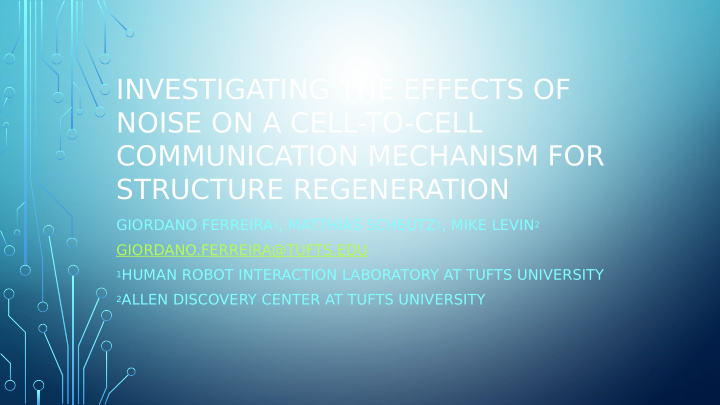



INVESTIGATING THE EFFECTS OF NOISE ON A CELL-TO-CELL COMMUNICATION MECHANISM FOR STRUCTURE REGENERATION GIORDANO FERREIRA 1 , MATTHIAS SCHEUTZ 1 , MIKE LEVIN 2 GIORDANO.FERREIRA@TUFTS.EDU 1 HUMAN ROBOT INTERACTION LABORATORY AT TUFTS UNIVERSITY 2 ALLEN DISCOVERY CENTER AT TUFTS UNIVERSITY
INTRODUCTION 2
INTRODUCTION • Note that the shape to which an animal regenerates upon damage can be altered without genetic changes • For example, it is possible to produce two headed planarian worms • Genes and proteins involved in regeneration are known, but the 3 exact mechanism of storing and using morphological information for
COMPUTATIONAL MODEL OF MORPHOLOGY DISCOVERY AND REPAIR • We previously developed a model that could discover the morphological information of an organism, during a discovery phase • Later, when the organism was lesioned the dynamic messaging mechanism in the model was able to cause regeneration of the damaged parts • While the model has not been linked to biological mechanisms yet, it has demonstrated a variety of functional 4 properties of regeneration displayed by planaria
FEATURES OF THE MODEL • Proposed in Ferreira et al. 2016 3 • Morphological information is stored in a dynamic distributed fashion across cells • The genome is hypothesized to encode the computational machinery necessary for carrying out morphological discovery and repair • A key feature of the model is that it can dynamically learn and maintain new morphologies using the same computational mechanism 3 Ferreira, G. B. S., Smiley, M., Scheutz, M., and Levin, M. (2016). Dynamic structure discovery and repair 5 for 3d cell assemblages. In Proceedings of the Fifteenth International Conference on the Synthesis and Simulation of Living Systems (ALIFEXV)
DISCOVERY Cells send messages to other cells containing information about the 6 path that those messages traveled.
REGENERATION Then those message packets ”backtrack” verifying 7 if there exists a missing cell in the previous path, repairing it.
REGENERATION 8
REGENERATION 9
PREVIOUS FINDINGS • In Ferreira et al (2016) 3 we showed that this model was capable of maintaining the structure of the worm indefjnitely in the light of random damages happening to parts of it • However, communication was assumed to be perfect and without losses, which is not realistic in any actual organism • Hence, the goal of this work was to investigate the extent to which the model can handle various types of noise 3 Ferreira, G. B. S., Smiley, M., Scheutz, M., and Levin, M. (2016). Dynamic structure discovery and repair 10 for 3d cell assemblages. In Proceedings of the Fifteenth International Conference on the Synthesis and Simulation of Living Systems (ALIFEXV)
EXPERIMENTS WITH NOISE ON PACKETS 11
NOISE ON DISTANCE 12
NOISE ON DISTANCE 13
NOISE ON DIRECTION 14
NOISE ON DIRECTION 15
NOISE ON DIRECTION 16
EXPERIMENTS WITH NOISE ON PACKETS 17
RESULTS OF EXPERIMENTS WITH PACKETS CONTAINING NOISE • The model completely regenerated the simulated worm in 63% of the parameter space with no noise • The model completely regenerated the simulated worm in 0% of the parameter space that contained noise 18
REGENERATED WORMS Worst worm: Sim = 0.181 19 Original worm: Sim = 1 Best worm: Sim = 0.828
ACTIVATION MECHANISM - NOISE 20
ACTIVATION MECHANISM - NOISE 21
ACTIVATION MECHANISM - NOISE 22
ACTIVATION MECHANISM 23
ACTIVATION MECHANISM 24
ACTIVATION MECHANISM 25
ACTIVATION MECHANISM 26
ACTIVATION MECHANISM 27
RESULTS OF EXPERIMENTS WITH THE ACTIVATION MECHANISM • The model completely regenerated the simulated worm in 39% of the parameter space with no noise (63% without the activation mechanism) • The model completely regenerated the simulated worm (with 100% similarity) in 5.7% of the parameter space that contained noise, compared to 0% of the parameter space without the activation mechanism 28
REGENERATED WORMS Original worm: Sim = 1 Best worm without the activation Worst worm with activation 29 mechanism: Sim = 0.828 mechanism: Sim = 0.664
CONCLUSION • We investigated our model of dynamic messaging morphology discovery and repair under various conditions of noise and proposed simple extensions to overcome the detrimental efgects of noise • Large parameter sweeps of the model determined that in about 6% of the parameter space the model was able to fully regenerate the original morphology with noise on the direction of packets • We are currently investigating why the proposed extensions do not suffjce for noise on packet distances 30
Recommend
More recommend